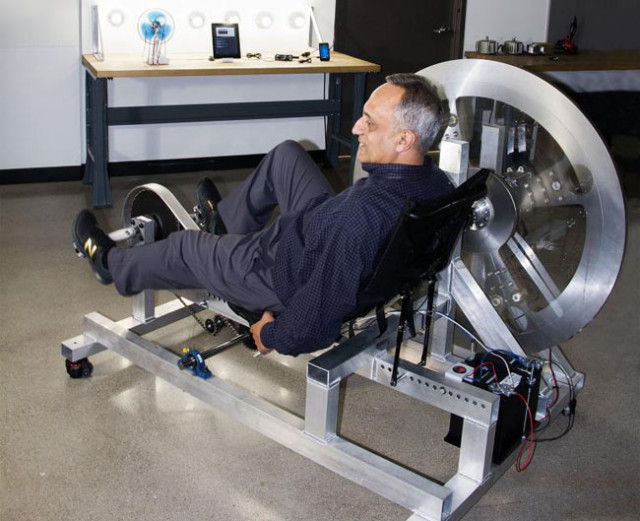Wouldn’t it be great to power your home without having enormous costs to starting a journey on the alternative road? Now, you can achieve that and also take care of your figure! The founder of the Free Electric hybrid bike, Manoj Bhargava, says that his invention uses mechanical energy in the most basic way in order to transform an hour of exercise into supplying rural household with energy for 24 hours. The mechanism is simple: when you pedals, a flywheel is put in action, which turns the generator and thus charging a battery. What better motivation to work out from now on than to power your own home without any costs whatsoever? Watch the video featured to see the bike in action.
https://youtu.be/Cgb9lfKW_d4
via TrueActivist



















Might power your house for 24 hours if you lived in a cardboard box.
Maybe you just waste a lot of energy.
If they are elite athletes and cycle 12 hours a day they might produce 4 or 5 kw-hrs. The average US home uses about 30 kw-hrs a day. Just a fridge would use most of that.
Luxury!
depends on the battery bank size, how many amps the bicycle is kicking out with an alternator and how many appliances are running off propane ….. switching to LED lighting can seriously cut down on usage and dependency on electricity
Even a Tour de France rider would struggle to produce more than 1KWh per day – fine for LED lighting, charging a phone and running a laptop computer, add a fridge to that and you’re done. You can forget about desktop computers or washing machines.
And at the rate the guy in the video was pedaling he’d be lucky to generate 50watts. So that’s 50 watt-hours to run a house for 24 hours? Uh…
Battery bank size has little bearing. Video shows 10 amps at 12 volts. that’s 120 watt hours. A 10ah battery out of child’s toy car would be all you need. A 6,000ah battery would only give you 10ah if that is all charge you put in it. And that will run a 5 watt led bulb for 24 hours. With 1 hour of peddling that’s all you are going to get.
Some people do live in a cardboard box, with their families, this solution is for them.
That’s not very kind.
I live in a cardboard box and I would not consider this solution.
One solar panel can give me more power than that bike and a solar panel with charge controller is cheaper. A solar panel does not wear out and one person can handle such panel. Best of all, I do not have to peddle.
Actually solar panels do wear out. Everything has a life span. Also how much energy this produces depends on how the gears are set up. If you have a 12 speed bike you can pedal hard or slow, depends if you are going up a hill or on a straigh away. This may be geared to do the least amount of pedalling for the most energy.
Then I doubt they have the money to spend on this scam.
wonder what he himself was envisioning a household to be…
This makes 1050 kilowatts a day. The average household uses about 600 kw a week. Do the math.
Where and How can I get hold of one of these power/pedaling machines?
Thank you
Aguinaldo Filho
GREAT where can you buy the bike
I’d like to know how to get one of these.
How to emitt energy?
A better method of generating green energy would be to attach a dynamo to Newton’s coffin because he’s spinning in his grave from this affront to very elementary physics
A flywheel defies physics?
Average person that is in decent to good shape can produce about 600 – 800 watts. Very few can sustain that for more than a few minutes unless they are in very good shape. So on a good day, an average person might produce 1/2 a kilowatt hour, if they really tried. Don’t know about you, but my house uses 34 kwh a day in low season. A flywheel doesn’t defy physics Kevin, but it doesn’t add any sort of multiplying affect
Although I appreciate the amusing visuals I got from your comment, however I do not understand how this is an affront. Force turns a generator which then creates a current… the force may be water… wind… legs… Maybe you are suggesting that a human couldn’t possibly provide enough physical power to generate a substantial amount of electricity?
It is an affront. The best cyclists in the world can generate around 400W. The average person can do 100W. Assuming you can do 200W in 1 hour you will develop 200Wh of electricity. By comparison our family home with 2 adults and 3 kids uses 25kWh per day, or over 600 times as much power. That is why this stupid advert is an affront.
perhaps you missed the part that says, “…in order to transform an hour of exercise into supplying RURAL household with energy for 24 hours.” Rural being the operative word. This usage of rural is often time used in the context of developing nations or locations where power consumption is no where near “the average US house.”
RURAL third world country
The average US house uses 30kwh per day. So you would need to cycle at a constant 30000w for an hour (assuming perfectly efficient machine).
The best Tour De France Cyclist can manage 450w for an hour.
You would probably need 100 Tour De France Cyclists at full speed for an hour to power an average house for a day.
The average US house is wasteful as hell. I think the intention for these is developing countries where people live with very little electricity right now, so they would be powering only very essential electronic items.
My husband and I have a 500 sq ft cabin and we live off the grid now using solar. We went from a 1500 sq ft home, using 25 KW per day and now we use 2 KW per day. I would love something like this bike to help charge batteries on rain days. We have a propane stove and hot water heater but a normal fridge and washing machine. We also have computer and internet, but no TV. I agree with Heather. It is about lowering consumption as well.
The voice of reason finally. Correct. This a very interesting man. He created the 5-hour energy drink, and something like 90% of the profits goes to help in undeveloped countries. He’s not trying to power your Play Station and 80in Smart TV’s . . .he’s trying to bring power to people who would appreciate some lights or a fan.
exactly. ones who feel it defies physics either don’t know physics or work for the big corporations. it doesn’t take squat to illuminate a stack of 12v bulbs and run a radio/tv. they ALL run off of 12v inside.
as for heat and cooking, there are other alternatives as well. this device above would work in 3rd world. or for the preppers.
100% accurate Heather.
Donna, You really can not compare your prior home with your off grid, you swapped electric powered appliances with gas powered ones.
Larry, the man is trying to get money from donations. People in those countries need to tend fields and livestock and do not have time nor the energy to paddle a bicycle for an hour. A solar panel is cheaper and provides power while working the fields.
Dan, If a 120 v light bulb uses 60 watts and a 12 volt bulb uses 60 watts, then both bulbs are using the same energy. Many RV’s are using gas and generators and that is why it looks like they use little and who wants to go camping all the time.
A solar panel would be better and would have a live of 40 years or better, while this bike has moving parts that wear out and who would replace and order bike parts in 2-3 years when they wear out.
the average household is 120v not 12v, if a household is planned from the beginning to be as efficient as a RV then the amount needed is way less… and if the heavy flywheel is geared right and hooked up to a high amp alternator , a large battery bank can be charged rather quickly
Dan with a heavy flywheel and the right gearing a Pinto motor will power an Euclid for about 2 or 3 minutes at 5,000 RPM. But the power is not increased by thesis.
A cyclist is pedaling with a force to move his own weight and the weight of the bike. A stationary bike isn’t going anywhere and the flywheel isn’t that heavy, which would allow a more advantageous gear ratio, faster rotation, and more power generation.
The best comment that I saw.
What Gabriel said!
Could not agree more.
Brilliant response. <3
That IS great!!! but where do we purchase this bike?
How do I get one of these?
Where is the electricity producing bike sold and how much is it? Please include this in your articles, otherwise featuring products that you can’t have is rather mean and pointless.
Yes, I agree,they always post stuff and never let you know where to get it and how to do it.
Bull crap!!!
At best a 75ah battery. Even the cable size gives it away.
It.might power a dollhouse.for 24 hours.
Since u dont sell products, do u have a link where we can purchase it?
Where can I buy one of these bicycles??
How do you buy/ get one of these? We are living on a block no power we really this,
Where can I buy one?
This is physically impossible. The average person can produce about 50-150 watts per hour. A trained, competitive cyclist can produce about 400 watts an hour. Even if this device was 100% efficient (which is also impossible) and an amazingly fit person uses this system, we’re talking about having16.667 watts per hour available over a 24 hour period. So unless your entire electrical load is 2 small LED lights, this is just ridiculous click-bait.
I’m guessing the author of this article performed zero fact checking.
Shameful you can showcase a product on your site such as this without truly understanding the data that you … must have seen? If you saw no data, there’s no excuse. If you saw data you need better analysts. In what world does one hour on this bike power a home for 24 hours?
Do you know what kind of power this unit produces per hour? … how it’s stored and in what form? … what type of appliances can use this stored energy? Are you aware of the enormous amount of wattage a typical household consumes in 24 hours? I can tell you, a multitude times more than that which a human biking one hour on this unit can produce. As well, I’ve never seen a typical household run appliances or common light bulbs on a DC current.
I was wondering where I could get this bike and who could help me set it up. I live alone and on very limited finances. Riding a bike for one or two hours would be a piece of cake. Please help me find out how to obtain one . Thank You.
> “without any costs whatsoever”
… you know, aside from the cost to bring in an extra 4,000 calories plus other nutrients each day into your diet, the one hour opportunity cost of time that could have been spent more effectively, initial purchase costs and daily wear and tear on what I imagine to be a rather expensive bicycle (in addition to the expensive batteries used to store the day’s energy, which don’t tend to be as efficient as they should be and degrade rapidly).
But yeah, aside from those costs, it’s free energy!
Exactly.
I live off grid this is possible you dolts I run down only 9.6 amps in a 24 hr period running a fridge with freezer a small freezer a monitor in cold months a new tv that uses less than or close to .5 amps a water pump and flourecent lighting. my system is a 48 volt battery set up.
You are definitely the exception to the rule.
It reminds me of a story. Somebody advertised saying ‘machine to kill bed bugs – just for Rs.100 Orders started pouring in with money order for Rs100. Finally all got their parcels with 2 small tile pieces in and instructions ‘catch d bedbug, place it on one tile and smash it with the other.
It looks like, as the world advances some are going backwards. What about the time and energy required for the person to peddle the cycle? When we are in the age of solar and wind power this idea does not sound feasible.
Yes so now we have all realised that this is rubbish.. if it wasn’t then it would be available somewhere.. I saw the same thing I think a few years ago.. I truely expected it to be in production by now but of course its only a mock up and a con.. unless you know otherwise of course!!!!
24 hours of electricity. Not for an american home. never. but for a 3rd world home that isn’t packed with appliances, and only needs to power maybe one or two lights and a radio or computer, maybe. I’m kind of dubious.
Besides, the 3rd world home that uses very little electricity (or none) might have maybe $20 they could pay for this device. Somehow I doubt that anyone’s ever going to sell it for $20. Solar panels probably much cheaper a way to provide electricity to that rural home. And those people probably do difficult physical work all the time and do not need to waste the energy they put into themselves burning extra calories to convert it to electricity. Only people in the 1st world have extra energy that they want to burn in this inefficient way.
And as always a useless story. It gives no details about thepower out put, storage ccapacity, if it is avaliable or where to get it from.
Your site has to employ people so how about having them do some research.
don’t panic, they just got the times mixed up , they meant to say “if you pedal for 24 hours, it will power your home for 60 minutes” that’s cleared that up.
Too funny Mr Dread!
I live off Grid and I would love more information on this??please
Anyone ever see Soylent Green?
This is shameful I agree. The typical uk household uses on average uses 10kwhr of energy which translates to 36MJ. Well 1 Kcal is roughly 4000J so you’d need to burn around 9000 Kcal to power the house. A typical session may be around 600 Kcal and that amount of energy would only power a 60W bulb for 11 hours. I think this advert is totally obsurd and clearly miss informed!
Watts per hour doesn’t make sense. Watts are the unit of power meaning the rate at which energy is transferred or transformed. 1 watt is 1 joule per second
They are used for electricity in India, for powering lights and such in areas where electricity is either too expensive or not available. They wouldn’t be as useful in the US or Europe, where people use ridiculous amounts of electricity all the time.
A 3rd world home that uses very little electricity (or none) might have maybe $20 they could pay for this device. Somehow I doubt that anyone’s ever going to sell it for $20. Solar panels probably much cheaper a way to provide electricity to that rural home. And those people probably do difficult physical work all the time and do not need to waste the energy they put into themselves burning extra calories to convert it to electricity. Only people in the 1st world have extra energy that they want to burn in this inefficient way.
Google “free electric hybrid bike” and you’ll find this claim has been debunked.
Nice idea, but its not true. Or possible. A worldchampion cyclist is measure to have a power output of about 500W, while an average cyclist might have an output 200-300W. According to tables of “Functional Threshold Power “, widely used by cycklists and trainers.
During one hour of cyckling an average person will produce approx 0,3 kWh of energy. This is the same amount of energy required to
– heat 3 litres of water to its boiling point, while the champion could heat 6 litres of water.
– power a common household heater for 15 minutes.
Far far far from enought to power a household for 24 hours.
If you do a search on this bike, you’ll see that the inventor, who is Indian, designed this to power poor, rural homes in India. They use a very small fraction of the power that us gluttonous Americans do, so NO, this bike would NOT power a home in the US.
But that poor Indian home might have maybe $20 they could pay for this device. Somehow I doubt that anyone’s ever going to sell it for $20. Solar panels are probably a much more cost-effective way to provide electricity to that rural home.
And those people probably do difficult physical work all the time and do not need to waste the energy they put into themselves (i.e. food) burning extra calories to convert it to electricity. Only people in the 1st world have extra energy that they want to burn in this inefficient way.
These should be in fitness centres.
Combine it with local solar power.
This bike was created by the creator of 5 hour energy and as far as I know it is not available for consumer purchase
My guess is you have to hook it up to a power generator
Gearing ratios/ flywheels!
Please look up this man and his inventions. This bike was designed to supply poor rural households in Inda (where they don’t have any electricity supply, let alone the demand required by western households).
Pedaling for an hour on Manoj Bhargava’s ‘Free Electric’ hybrid bike can supply 24 hours of electricity for a rural household.
In a world where up to half of the population either has no access to electricity whatsoever, or only severely limited access, a home energy device powered by humans could have a big impact in the developing world, and one philanthropist is willing to put his money where his mouth is in order to potentially change the lives of billions.
Manoj Bhargava, founder of the company that makes the popular energy-boosting supplement 5-hour Energy, is worth somewhere in the neighborhood of $4 billion, and instead of spending that money on luxury items or a lavish lifestyle, he’s focused on making a difference in the world, in part by tackling some of the pressing issues of our time, most notably energy and water. Bhargava has pledged 90% of his wealth to charity and research via the Bill and Melinda Gates and Warren Buffett-led Giving Pledge, saying:
“Service to others seems the only intelligent choice for the use of wealth. The other choices especially personal consumption, seem either useless or harmful.”
Bhargava also founded the Billions in Change movement, which aims “to build a better future by creating and implementing solutions to serious problems facing the world in the areas of water, energy and health.” A new documentary outlines several innovations that have the potential to make a very real impact on the lives of many, including a stationary bike generator, a new medical device, a new take on geothermal energy, and a method of producing potable water at scale.
The first of these devices, the Free Electric hybrid bike, is described as “small, light, and simple,” and said to be able to supply a rural household’s electricity needs for 24 hours with a single hour of pedaling. A person pedals the bike, which drives a flywheel, which then turns a generator and charges a battery, and in a ‘village’ setting, one bike could be bought with pooled funds, and then additional batteries for individual homes could be charged and then swapped out as needed.
Where can I learn more about this, from an independent source preferably. Where can I get one and how much does it cost?
Where can you purchase one of these hybrid bikes?
How much and where do I get this
The amount of energy the Hans Free Electric™ bike generates in an hour depends on how hard you want to pedal, and also whether you’re simply charging the battery, or also running powered devices while pedaling. For the commercial version of the bike (two flywheels), we estimate that the range of energy generation from easy-to-hard pedaling is about 50-200 Watts per hour. The consumer version of the bike (one flywheel) is easier to pedal, uses a smaller battery, and generates about 30-100 Watts per hour. The Hans Free Electric™ Power Pack that will accompany the consumer version of the bike stores 148 Watt-hours, while the commercial Power Pack can store 296 Watt-hours. Both batteries have maximum outputs of 160 Watts and are fused at 10 amps.
If you think people are stupid , believe me they are even more stupid than you ever can imagine. If have a AAA battery and my whole house can be powered on it for one week.
Sheez…any measurable electricity generated by this invention would be bonus and incentive to exercise regularly!!!
You are not turning the generator !! You are turning a flywheel that powers the generator !! Just as in a car its the flywheel thats connected to the transmission !! And if you had looked at the flywheel you would have noted how big it is !! Just like the one on the motor of a car the drive shaft is only one inch in diameter bit the flywheel is as big as the motor !! So do some math you might be surprised at the real output !!
If you mean 3rd world say 3rd world. I live in a rural home. No way this powers my home.
Let’s see. The man with a family of two adults and three children uses more than the average amount of electricity. But, if you take these same two adults and three children and let them take turns on this electro bike, LOOK at how much energy could be generated. An added bonus is that there will be five less obese people with health problems. It’s a Win…WIN !!
This is the best thing ever!
I am very interested in this! I just need very little power and this would be great for me.
If I have a lever long enough I can move the world. if a standard bicyclist can do 200 Watts one with a bicycle made to convert energy would do a hell of a lot more. Gears and the principle of leverage etc.
Why now use a sun-tracking magnifier to heat a Sterling engine?
I wonder how long it will be before he ends up dead like the guy who invented a car that ran on water.
If you are running that kind of current on a 48 volt system, you’re still using 460W. As previously mentioned, a world class cyclist can produce around 400W. This still, even if the bike is 100% efficient, will not work and I’m sure that being off grid you’ve done your best to find the most efficient devices possible.
That could easily be reduced. That is pretty excessive.
I agree. Great comment!
These are not for normal homes in England ar any other fully modern nation. These are for undevelopef nations where that want to have a single light bulb and maybe a refergerator. It is,also good for “preppers” and those who choise to live off the grid. Go back and read the comments from Feb 2016, several “off the grid” types responded.
The math here scares me. Not from the video, but the posts using Tour deFrance riders output numbers. Grab a calculator and do the math for real before posting it please – Such simple mistakes undermine your whole argument.
Physic said:
The best cyclists in the world can generate around 400W. The average person can do 100W. Assuming you can do 200W in 1 hour you will develop 200Wh of electricity. By comparison our family home with 2 adults and 3 kids uses 25kWh per day, or over 600 times as much power.
REAL MATH CORRECTION: The actual number is 125x more power, not 600 – SMDH
Rob said:
The average US house uses 30kwh per day. So you would need to cycle at a constant 30000w for an hour (assuming perfectly efficient machine). The best Tour De France Cyclist can manage 450w for an hour. You would probably need 100 Tour De France Cyclists at full speed for an hour to power an average house for a day.
REAL MATH CORRECTION – 66.66 (let’s call it 67) riders are needed, not 100. – SMDH
Where can I buy one?
Is rather store and use the wattage I expel while exercising, than not, I imagine the naysayers are big fat fatties and dinosaur fu@kers.
It might run a few light bulbs, but anything beyond that is not possible. Cooking? You would have to expend all the energy collected to bring a 1qt pot to a boil.
Where can I get one and how much does it cost?
Assuming commenters here are right and this doesn’t produce enough energy to be worthwhile…
What about in a gym environment, where exercise bikes are used one hour after the next, and there are a room full of them? If every cyclist produced 200 W and the machines were used 6 AM to midnight, even at half-time (18 hrs/2 = 9 hours, let’s say 10 hours/day), then now you’re at 2000W/day for one bike (2 kW). Let’s say you have 20 bikes in the room, now you’re at 40 kW/day for the gym. Could a gym run on 40 kW/day? Would that help?
Finally a way for my kids to earn their keep.
If you check it out the company that invented this is Billions In Change. It is a brilliant invention. I wanted it for the exercise benefit, with the electricity as a bonus. However, they abandoned bringing it to production. For their company’s purposes it was a better business decision to mass produce solar products. I was hugely disappointed. They donated the prototypes that they had.
If you want us to take this seriously, we need data: OP Amps, Voltage etc and trivial things like how much does the device cost? how many batteries required, do you get an inverter? etc etc without this the whole thing is meaningless.
Ok although valid points are being made. Your confusing physical warts to mechanical. Yes a person generates 200 watts with no mechanical interface so your body pedaling a bike generates 200watts, now add a mechanical interface that can turn a larger fly wheel and turn a larger generator NOW your generating much more energy.
OMG, the comments from armchair rocket scientists. Keep your day job. Seriously, the picture clearly shows a human pedal powered flywheel turning a generator to charge one 12v battery… No math required to understand the concept, it’s potential and limitations. JFC…
A highly trained competitive cyclist can produce up to 300 -400 watts for an hour or so. This is, in electrical terms, 400 watt/hours and it doesn’t take into account the inefficiency of using a storage battery. If you have a 100 watt bulb, you can light it for four hours. If you have a 1 Kw kettle, you can use it for 0.4 hours. If you have a 2500 watt washing machine, you can run it for 0.16 hours. The idea of running a normal home for more than a few minutes from peddling a generator is, frankly, impossible and therefore this idea is completely impracticable! It is far more practicable to encourage scientists to research discoveries made over the last 100 years which have been suppressed by energy companies and Government.
I got exactly no information on how this bike works.
How does it tie into my home’s electrical system? Does it send unused electricity into the grid and to the buildings next to mine, like solar? Does it work with my panel? How many kilowatts of electricity are produced in an hour? Can it be stored outside? And lastly, how much does it cost???
So many questions, so little information. But it was a very feel good video, I’ll give them that.
I want this bicycle…how to contect you
I want one. I’d everybody in my house paddled for an hour a day, think how much pollution you could save. Where can I get in to touch with somebody about this?
Approximately 20 years ago I envisioned an application for a device similar to this one that would be used in prison reform to serve the dual purpose of inmate exercise and victim compensation. Realizing that everyone in our country has a need for electricity and/or the money its generation could provide. Producing a product that has universal value would add meaning to the physical efforts of inmates and could be a requirement for perks and extras prisoners desire. Every prison facility has ample manpower to power a multi-person machine that would produce electricity around the clock. The energy produced would first be sold to defer the operational costs of operating the prison. Work schedules would be devised so no one participating would be allowed to work beyond a healthy amount of time. Reduction in time of sentence would be related to time spent in energy production. There are many more advantages to this concept but prudent comment duration requires me to conclude now.
Information on cost and ordering
Do they make an electric version that you don’t have to pedal?
This is very inefficient. Nobody is going to want to work more than they already are to pay for their electricity. Knock that hour down to 15 minutes and then we’ll talk as long as it’s affordable.
How do you get one? I want one?
Good way to gets kids to earn their keep.
I think this could be the very beginning of the biggest step into the future of our homes and lifestyle. It’s better for the environment, its better for the economy, and its better for your health. I believe this is huge for those in poverty across the world especially!
I live in the UK, I use my push bike for most of my transport, if the technology is supported further, I’m sure we could ‘bank’ energy on the go, eventually!
Bravo! Please let me know if I can be a quality test subject to help with the research!
If your home needs just 0.1kwh per day it will work.
A common human can produce 100 watt with his legs, and will be exhausted after 1 hour.
That’s why are no numbers in the presentation!
Cause it’s a big SCAM. 😀
I find this pretty laughable. It’s a first world solution to a third world problem. So the author thinks that all these people in poor countries with no infrastructure and no or spotty electricity are just sitting around with nothing to do? No these people are often just subsisting. How many calories do you think you need to burn to pedal this bike for 1 hour? Again, I am sure these poor people are all fat and need to lose weight, right? And he says there is no pollution, and wants to spread these around the world. Did I not spot a lead acid car battery hooked up to the bike? That is not what I would want to proliferate around the world. Also, the bike looks to be made of high test materials with a large heavy flywheel. The cost to manufacture and transport this to poor regions would be high. I would really like to see some honest numbers about the Watt-hours that this can actually generate with an average human input for 1 hour, and compare that to the needs that the author claims, as well as evaluating the materials and environmental costs of the bike.
Dear All, the visuals in the video are of remote villages in India that do not have access to the grid. They use at best 2 LED bulbs of 12 watts each. And they use the bulbs from say 6 – 9 pm. They normally do not have a fan. But they all have mobile phones and would need to charge them. So how many watt hours does that add up to? 60 watt hours? My main concern wit these kind of gadgets is maintenance, if it breaks down how will a villager fix it?
Where can I get the plans for this?